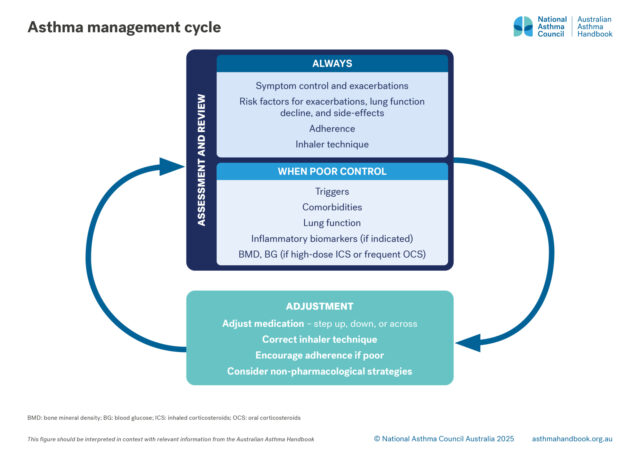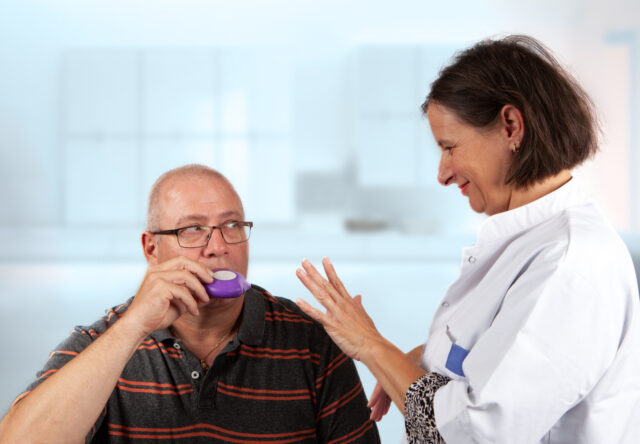Australian Asthma Handbook
The National Guidelines for Health Professionals
Cite
Table
| Mild–moderately severe | Severe | Life-threatening | |
| Assessment | All of: Can walk, speak whole sentences in one breath SpO2 (room air) >94% | Any of: Unable to complete sentences in one breath due to breathlessness Use of accessory muscles of neck or intercostal muscles/tracheal tug/subcostal recession during inspiration Obvious respiratory distress SpO2 (room air) ≤94% | Any of: Reduced consciousness/collapse, exhaustion Cyanosis Poor respiratory effort SpO2 (room air) <92% Poor respiratory effort, soft/absent breath sounds
|
| Triage | Manage in place | Arrange transfer to acute care | |
Immediate treatment | Give salbutamol 4–12 actuations (100 microg per actuation) via pMDI and spacer (tidal breathing method) | Give salbutamol 12 actuations (100 microg per actuation) via pMDI and spacer (tidal breathing). If patient cannot use spacer, 5 mg salbutamol nebule via nebuliser (if available) Start oxygen supplementation if SpO2 (room air) <92%.* Titrate to target SpO2 92–96% | Without nebuliser: Give salbutamol 12 actuations (100 microg per actuation) via pMDI and spacer ± mask (tidal breathing). With nebuliser: Give salbutamol 2 x 5 mg nebules via continuous nebulisation driven by oxygen: SpO2 target 92–96%* |
| Continued treatment | Repeat salbutamol 4–12 actuations every 20–30 minutes for the first hour, if needed (sooner if needed) | Repeat salbutamol 12 actuations at least every 20 minutes for first hour (3 doses) | Maintain SpO2 to target 92–96%* |
Additional information
SpO2: oxygen saturation measured by pulse oximetry; *88–92% for patients at risk of hypercapnoea
Table
| Mild–moderate (all of): | Severe (any of): | Life-threatening (any of): | |
| Consciousness | Alert | N/A | Drowsy or unconscious |
| Speech | Can finish a sentence in one breath | Can only speak a few words in one breath | Cannot speak |
| Posture | Can walk, sit up straight, lie flat | Unable to lie flat due to dyspnoea Sitting hunched forward | Collapsed or exhausted |
| Breathing | Respiratory distress is not severe | Paradoxical chest wall movement: inward movement on inspiration and outward movement on expiration (chest sucks in when person breathes in) or Use of accessory muscles of neck or intercostal muscles or ‘tracheal tug’ during inspiration or Subcostal recession (‘abdominal breathing’) | Severe respiratory distress or Poor respiratory effort |
| Skin colour | Normal | N/A | Cyanosis |
| Respiratory rate | <25 breaths/min | ≥25 breaths/min | Bradypnoea (indicates respiratory exhaustion) |
| Heart rate | <110 beats/min | ≥110 beats/min | Cardiac arrhythmia or Bradycardia (may occur just before respiratory arrest) |
| Chest auscultation | Wheeze or Normal lung sounds
| N/A | Silent chest or Reduced air entry |
| Oxygen saturation | >96% | 92–96% | <92% or Clinical cyanosis |
Additional information
N/A: Not applicable – may be the same as moderate and does not determine severity category
Recommendation type: Consensus recommendation
Routine objective assessment of oxygen saturation on room air at initial assessment of acute asthma is needed because clinical signs may not correlate with hypoxaemia. Pulse oximetry is the internationally accepted method for routine assessment of oxygen status in patients with acute asthma. It should be available in all situations in which oxygen is used.[Barnett 2022]
Barnett A, Beasley R, Buchan C, et al. Thoracic Society of Australia and New Zealand position statement on acute oxygen use in adults: 'Swimming between the flags'. Respirology 2022; 27: 262-276.
Hinkelbein J, Koehler H, Genzwuerker HV, Fiedler F. Artificial acrylic finger nails may alter pulse oximetry measurement. Resuscitation 2007; 74: 75-82.
Shi C, Goodall M, Dumville J, et al. The accuracy of pulse oximetry in measuring oxygen saturation by levels of skin pigmentation: a systematic review and meta-analysis. BMC Med 2022; 20: 267.
Yek JLJ, Abdullah HR, Goh JPS, Chan YW. The effects of gel-based manicure on pulse oximetry. Singapore Med J 2019; 60: 432-435.
Perform the assessment while preparing to administer salbutamol (and oxygen, if needed).
Pulse oximetry may overestimate oxygen saturation in people with higher levels of skin pigmentation[Shi 2022] and in people wearing nail polish or acrylic artificial fingernails.[Yek 2019, Hinkelbein 2007]
Transfer to an acute care facility should be arranged if respiratory distress is severe enough to prevent person speaking in whole sentences, or oxygen saturation ≤94%.
Recommendation type: Consensus recommendation
Mild–moderate exacerbation: 4–12 actuations
Severe exacerbation: 12 actuations
Repeat dose every 20 minutes for the first hour, if breathing difficulty not resolved.
If use of nebuliser is unavoidable, use 5 mg nebule for a severe exacerbation, 2 x 5 mg nebules for a life-threatening exacerbation.
Recommendation type: Consensus recommendation
Repeated administration of inhaled SABA every 20 minutes for the first hour is effective for rapidly achieving bronchodilation in patients with mild or moderate asthma exacerbations.[GINA 2025]
Among adults with acute asthma who do not require mechanical ventilation, salbutamol delivered via a pMDI with spacer is as effective as salbutamol delivered via nebuliser, and possibly more effective.[Cates 2006, Dhuper 2011]
The use of nebulisers may increase the risk of viral transmission.[Hui 2009, Biney 2024, Goldstein 2021] Healthcare workers should follow infection control procedures including use of personal protective equipment such as face masks.
Oral salbutamol or intravenous salbutamol are not recommended.
Biney IN, Ari A, Barjaktarevic IZ, et al. Guidance on mitigating the risk of transmitting respiratory infections during nebulization by the COPD Foundation Nebulizer Consortium. Chest 2024; 165: 653-668.
Cates CJ, Crilly JA, Rowe BH. Holding chambers (spacers) versus nebulisers for beta-agonist treatment of acute asthma. Cochrane Database Syst Rev 2006; Issue 2: CD000052.
Dhuper S, Chandra A, Ahmed A, et al. Efficacy and cost comparisons of bronchodilatator administration between metered dose inhalers with disposable spacers and nebulizers for acute asthma treatment. J Emerg Med 2011; 40: 247-55.
Global Initiative for Asthma (GINA). Global Strategy for Asthma Management and Prevention, 2025. Available from: www.ginasthma.org
Goldstein KM, Ghadimi K, Mystakelis H, et al. Risk of transmitting coronavirus disease 2019 during nebulizer treatment: a systematic review. J Aerosol Med Pulm Drug Deliv 2021; 34: 155-170.
Hui DS, Chow BK, Chu LC, et al. Exhaled air and aerosolized droplet dispersion during application of a jet nebulizer. Chest 2009; 135: 648-654.
National Asthma Council Australia’s video on how to use a metered dose inhaler (puffer) with a spacer for adults
National Asthma Council Australia’s fact sheet on spacers for pressurised metered-dose inhalers
Tidal breathing method:
1. Connect spacer to pMDI and tell patient to seal lips firmly around spacer mouthpiece.
2. Shake the inhaler well
3. Release 1 actuation of salbutamol into the spacer.
4. Tell the patient to breathe in and out for four breaths while keeping lips sealed around mouthpiece.
Repeat process until all required actuations delivered, shaking inhaler again before each actuation then releasing 1 actuation into the spacer at a time before patient inhales.
If the person cannot seal their lips tightly around the spacer mouthpiece, use a tightly fitting adult mask connected to the spacer mouthpiece.
If the patient cannot breathe through a spacer using either the mouthpiece or a mask, use a nebuliser with mask.
The tidal breathing technique should only be used while the patient is too breathless to use the standard single-breath technique. Once breathing improves, consider switching to single-breath technique.
This oxygen saturation target applies to patients not considered to be at risk of hypercapnoea.
The recommended oxygen saturation target for patients at risk of hypercapnoea is 88–92% (see Considerations).
Follow current guidance in Thoracic Society of Australia and New Zealand’s position statement on acute oxygen use in adults.
Recommendation type: Consensus recommendation
Hypoxia is associated with life-threatening acute asthma. Clinical signs may not correlate with hypoxaemia – monitor with pulse oximetry.[Barnett 2022]
Oxygen should be administered if the SpO2 is less than 92%, and titrated to a target SpO2 range of 92–96% using pulse oximetry (88–92% for patients at risk of hypercapnoea).[Barnett 2022]
The aim of titrated oxygen therapy in acute care is to achieve adequate oxygen saturation without causing hypercapnoea.[Barnett 2022] Adults with acute asthma and those with both asthma and COPD are at risk of hypercapnoeic respiratory failure.[Barnett 2022]
For most patients, the use of standard nasal cannulae is the preferred method of oxygen delivery, with the flow rate varied to achieve the target oxygen saturation.[Barnett 2022]
Pulse oximetry does not detect hypercapnoea. The emergency department will conduct blood gas analysis in patients with severe or life-threatening acute asthma or if hypercapnoea is suspected.[Barnett 2022]
Barnett A, Beasley R, Buchan C, et al. Thoracic Society of Australia and New Zealand position statement on acute oxygen use in adults: 'Swimming between the flags'. Respirology 2022; 27: 262-276.
Hodder R, Lougheed MD, Rowe BH, et al. Management of acute asthma in adults in the emergency department: nonventilatory management. CMAJ 2010; 182: E55-67.
Shi C, Goodall M, Dumville J, et al. The accuracy of pulse oximetry in measuring oxygen saturation by levels of skin pigmentation: a systematic review and meta-analysis. BMC Med 2022; 20: 267.
Pulse oximetry may overestimate oxygen saturation in people with higher levels of skin pigmentation.[Shi 2022]
If SpO2 is 85%–91%, oxygen can be initially instituted at 2–4 L/min via nasal cannulae or simple face mask, and titrated to achieve the target SpO2.[Barnett 2022]
If SpO2 is <85%, oxygen can be initiated at 4 L/min via nasal cannulae, through a simple face mask at 5–10 L/min or 100% non-rebreather reservoir mask at 15 L/min.[Barnett 2022]
Refer to TSANZ guidance for other options and details.
Recommendation type: Consensus recommendation
Perform a physical examination including vital signs, auscultation, and continue monitoring pulse oximetry.
See Table: Secondary severity assessment in adults & adolescents in primary care
Complete a brief history, including:
Recommendation type: Consensus recommendation
The association of asthma and food allergy is a risk factor for fatal and near-fatal allergic reactions to food allergens.[Burks 2012]
Burks AW, Tang M, Sicherer S, et al. ICON: food allergy. J Allergy Clin Immunol 2012; 129: 906-920.
Adults: prednisone/prednisolone 37.5–50 mg orally, then repeat each morning on second and subsequent days (total 5–10 days).
Adolescents: prednisone/prednisolone 1 mg/kg (maximum 50 mg) orally once daily for 3–5 days.
Recommendation type: Consensus recommendation
In adults and adolescents with acute asthma, systemic corticosteroids given within 1 hour of presentation to an emergency department reduce the need for hospital admission.[Rowe 2001]
It is not necessary to taper the dose after a short course of oral prednisone/prednisolone.[Rowe 2017, O’Driscoll 1993]
Short-term safety: Short courses of oral corticosteroids to treat acute asthma are often well tolerated by adults,[Rowe 2001, Rowe 2007] but patients may report mood changes, sleep disturbance, or gastrointestinal effects (gastro-oesophageal reflux, constipation, bloating).[Berthon 2015] In patients with diabetes or impaired glucose tolerance, blood glucose monitoring (e.g. morning and evening samples) may be indicated during treatment with oral corticosteroids.
Long-term safety: over a lifetime, exposure to multiple short courses of oral corticosteroids to manage asthma exacerbations is associated with increased lifetime risk of osteoporosis, pneumonia, cardiovascular or cerebrovascular diseases, cataract, sleep apnoea, renal impairment, depression/anxiety, type 2 diabetes, and weight gain.[Price 2018] Most adverse effects are seen with cumulative doses of 1.0–<2.5 g, but increase risk for some adverse effects is seen at cumulative doses equivalent to four courses over a lifetime.
Berthon BS, Gibson PG, McElduff P et al. Effects of short-term oral corticosteroid intake on dietary intake, body weight and body composition in adults with asthma – a randomized controlled trial. Clin Exp Allergy 2015; 45: 908-19.
O’Driscoll BR, Kalra S, Wilson M, et al. Double-blind trial of steroid tapering in acute asthma. Lancet 1993; 341: 324-327.
Price DB, Trudo F, Voorham J, et al. Adverse outcomes from initiation of systemic corticosteroids for asthma: long-term observational study. J Asthma Allergy 2018; 11: 193-204.
Rowe BH, Kirkland SW, Vandermeer B et al. Prioritizing systemic corticosteroid treatments to mitigate relapse in adults with acute asthma: a systematic review and network meta-analysis. Acad Emerg Med 2017; 24: 371-81.
Rowe BH, Spooner C, Ducharme F, et al. Early emergency department treatment of acute asthma with systemic corticosteroids. Cochrane Database Syst Rev 2001; Issue 1: CD002178.
Rowe BH, Spooner C, Ducharme F, et al. Corticosteroids for preventing relapse following acute exacerbations of asthma. Cochrane Database Syst Rev 2007; Issue 3: CD000195.
Prescribers should avoid supplying parents with more prednisone/prednisolone than needed for the course. Prescribers may write PBS scripts for less than the maximum quantity and number of repeats permitted if a lesser quantity is sufficient for the patient’s requirements.
If symptoms recur, the supervising person (e.g. primary care nurse or family/carer) should administer salbutamol and call an ambulance.
Recommendation type: Consensus recommendation
Provide written instructions:
Recommendation type: Consensus recommendation
Checkup at day 3–5 aims to check whether symptoms have resolved and assess adherence to oral corticosteroids (if prescribed) and ICS.
The purposes of a comprehensive asthma review after resolution of an exacerbation are:
If the patient’s current treatment regimen is budesonide-formoterol only as needed, step up to MART.
If the patient’s current treatment regimen includes a low dose of ICS, consider stepping up to a higher dose for a few weeks then reviewing.
Information on assessing and reviewing asthma in adults & adolescents
Doses using ampoule (1:1,000) and syringe:
Patients >12 years or >50 kg: adrenaline 0.01 mg/kg (up to 0.5 mg per dose) IM into lateral mid-thigh
Recommendation type: Adapted from ASCIA 2024
Anaphylaxis should be suspected when asthma-like respiratory symptoms are accompanied by either of the following features: [ASCIA 2024]
ACAQH. Immediate injection of intramuscular adrenaline. Quality statement 2. Australian Commission on Safety and Quality in Health Care. https://www.safetyandquality.gov.au/standards/clinical-care-standards/acute-anaphylaxis-clinical-care-standard/quality-statements/immediate-injection-intramuscular-adrenaline
ASCIA. Acute management of anaphylaxis. 2024, Australasian Society of Clinical Immunology and Allergy.
Australian Prescriber’s Anaphylaxis: emergency management for health professionals wallchart
ASCIA Guidelines: Acute management of anaphylaxis
When anaphylaxis is suspected adrenaline should be given immediately,[ACAQH 2025] and before considering salbutamol.[ASCIA 2024]
via auto-injector: 300 microg IM
Recommendation type: Consensus recommendation
Adrenaline is not used routinely in the management of severe acute asthma.
Its use should be reserved for situations where inhaled salbutamol cannot be given in a patient with respiratory arrest or pre-arrest status, or when anaphylaxis is suspected.
There is insufficient evidence to determine whether inhaled salbutamol is more effective than adrenaline as first-line treatment in the management of severe acute asthma, due to high risk of bias in published clinical trials and significant heterogeneity, including differences in study design.[Baggott 2022] Available evidence suggests adrenaline may be more effective in adults than in children.[Baggott 2022]
Low-quality evidence suggests that adrenaline is associated with higher rates of agitation, tremor and headache than inhaled salbutamol. [Baggott 2022]
There is also insufficient evidence to determine whether intramuscular adrenaline, given in addition to inhaled salbutamol, is more effective than inhaled salbutamol alone.[Baggott 2022]
Ambulance Victoria. Clinical practice guidelines. Version 3.12.15 (2024).
Baggott C, Hardy JK, Sparks J, et al. Epinephrine (adrenaline) compared to selective beta-2-agonist in adults or children with acute asthma: a systematic review and meta-analysis. Thorax 2022; 77: 563-572.
International asthma guidelines recommend inhaled salbutamol as the primary bronchodilator in acute asthma, and do not recommend the use of adrenaline except for patients with concomitant acute asthma and anaphylaxis or angioedema.[Baggott 2022] However, intramuscular adrenaline in addition to inhaled SABA is included in ambulance guidelines for prehospital management of acute asthma in some jurisdictions,[Baggott 2022] including in some Australian states. [Ambulance Victoria 2024]
Risk factors include COPD, obesity, obesity hypoventilation syndrome, bronchiectasis, cystic fibrosis, neuromuscular disease, and chest wall deformities (e.g. severe kyphoscoliosis).
Follow current guidance in Thoracic Society of Australia and New Zealand’s position statement on acute oxygen use in adults.
Recommendation type: Adapted from TSANZ 2022
Current Thoracic Society of Australia and New Zealand guidance recommends a SpO2 target of 88–92% in conditions associated with chronic respiratory failure, including exacerbations of COPD.[Barnett 2022]
Barnett A, Beasley R, Buchan C, et al. Thoracic Society of Australia and New Zealand position statement on acute oxygen use in adults: 'Swimming between the flags'. Respirology 2022; 27: 262-276.
Refer to TSANZ guidance for other options and details.
Single-breath technique is the standard, recommended method: one actuation is released into the spacer at a time. The patient takes a single slow deep breath after each actuation, then holds their breath for 5 seconds, then exhales away from the spacer.
Tidal breathing is the alternative method for use in a person with acute asthma who cannot coordinate their breathing with actuations. Up to 2 actuations are released into the spacer at the same time, and the patient takes multiple breaths (aim for four), breathing in and out through the spacer mouthpiece.
The tidal breathing method is usually used in EDs to deliver SABA in acute asthma, but patients should revert to the preferred single-breath technique after discharge.
Resources
Resources

Principles of management
How to assess asthma control and severity. Risk factors for asthma exacerbations and what to include at check-ups for…

Principles of management
How to equip and coach patients to manage their own asthma, including exacerbations.

Medication management
How to step up or step down asthma treatment for an individual patient to maintain control and minimise side-effects.